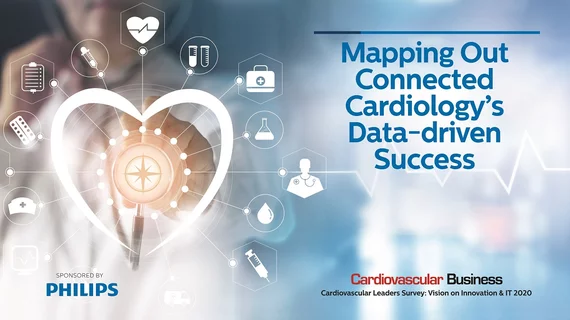Cardiovascular Leaders Survey: Contents
The Cardiovascular Business Leadership Survey shows healthcare organizations see cardiovascular image and information management systems as core to clinical and business functions essential for defining a data-rich path forward for more connected cardiology and better patient care.
- Survey at a Glance
- Priorities of the Cardiovascular Service Line
- Defining State-of-the-Art CVIS
- Key Findings
- What Healthcare Leaders Think
- Demographics
- About the Survey
This report reflects the input of physicians, executives, IT and administrative leaders in healthcare and cardiology from the United States (97%) and Canada (3%). We focus on the responses of 353 providers and professionals at the helm of healthcare systems, integrated delivery networks, academic medical centers, hospitals, cardiovascular service lines and cardiology departments and physician groups. For a deeper dive into survey demographics, turn to here.
Mary C. Tierney, MS, is the chief content strategist of Cardiovascular Business and CardiovascularBusiness.com, part of TriMed Media.
CVIS Leading the Way in Connected Cardiology
The Cardiovascular Business team’s goal for the Cardiovascular Leadership Survey was simple: Take the pulse of cardiovascular health and the business and IT structures supporting it, and gain insight on leaders’ vision for the future. We learned a lot—thanks to the 353 healthcare and cardiology leaders who chimed in—and we believe you will too.
The survey results reveal much about the state of the art and goals for the cardiovascular service line in 2020. They also identify the obstacles to supplying cardiology caregivers and administrators with the data, insight and tools they need to monitor and improve the health of patients and health systems.
Taken as a whole, these survey findings offer a roadmap from where we are to where cardiovascular leaders want to go. Reaching the destination will be a years-long journey. There’ll be plenty of starts, stops and sprints. Along the way, leaders need to find the best ways to streamline and unify data and information infrastructure across heart health and health systems. They’ll have to learn how to use data to improve care, operational performance and patient outcomes. And they’ll have no choice but to blaze new trails for moving patients into lower-cost settings while retaining quality, reducing readmissions and optimizing lengths of stay.
Following the lead of progressive health systems, the hub-and-spoke model will build efficiencies as hospitals become the sites for complex procedures and care for the acutely ill. Clinics, surgery centers and physician offices will offer some procedures while monitoring and treating less urgent needs. People are paramount at every point in the process. Leaders must attract and retain self-motivated physicians, clinicians and staff. The most successful also will find solutions to fight burnout.
Already, data-driven practice decisions are bringing proactive identification and prediction of patterns. Machine learning, deep learning, neural networks and other algorithmic illuminators are pointing the way to greater efficiency for patients as well as clinicians.
Central to this vision of a more connected cardiology, healthcare leaders tell us, is a single, tightly integrated, digital infrastructure uniting technology, people and processes. Data needs to be seamlessly shared across imaging and diagnostic devices, IT systems, EMRs and specialty apps and software. In the best-case scenario, the health of health systems will improve along with that of the communities they serve.
Cardiovascular image and information management systems (CVIS) are the compasses guiding this journey and renovation-in-progress. The best systems are equipped with an information-rich GPS of sorts, guiding drivers to clinical, operational and financial transformation. Integration services optimize connectivity and make the data hum. CVIS help set broad directions, chart specific paths and, where needed, make data-driven course corrections.
This report offers a snapshot of what health system and cardiovascular leaders think. Some of it validates, while some enlightens. It all helps guide leadership on a data-rich and insightful journey into the future.
Read the report...
Survey at a Glance
Priorities of the Cardiovascular Service Line
Defining State-of-the-Art CVIS
Key Findings
What Healthcare Leaders Think
Demographics
About the Survey
The 16-page report on the 2020 Cardiovascular Business Leadership Survey offers a snapshot of what health system and cardiovascular leaders think about priorities, challenges and trends. Some of it validates, while some enlightens. It all helps guide leadership on a data-rich and insightful journey into the future.


